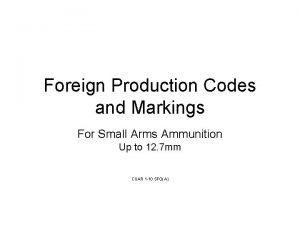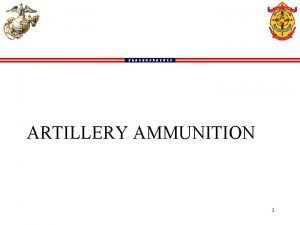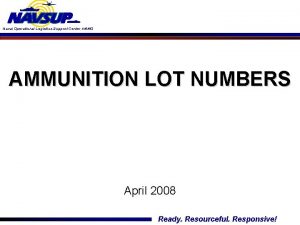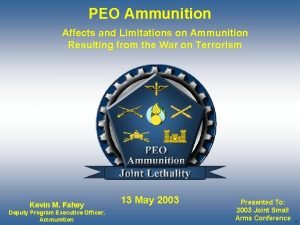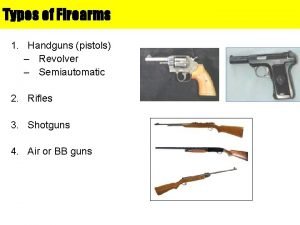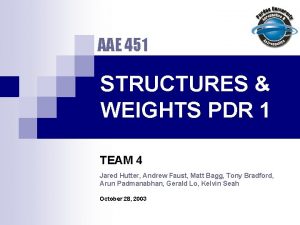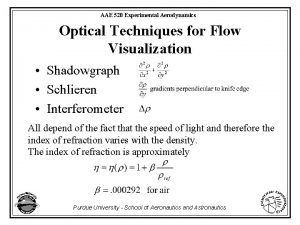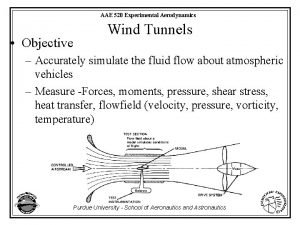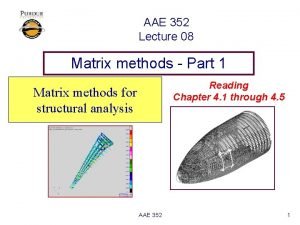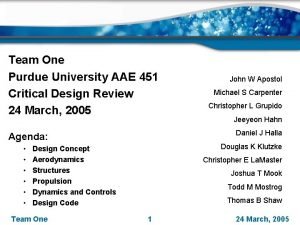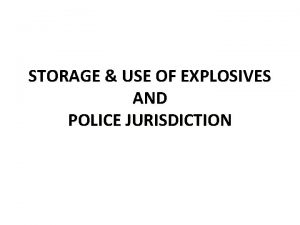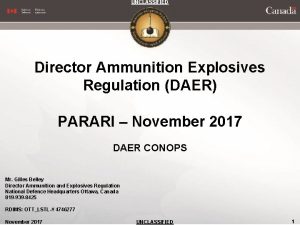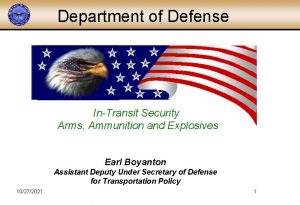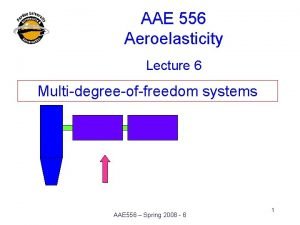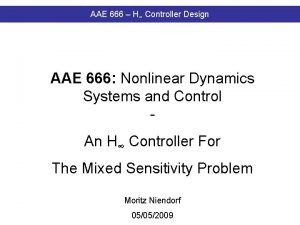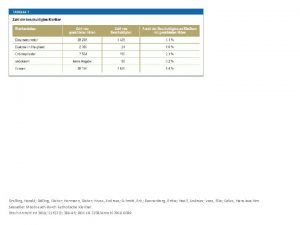Arms Ammunition and Explosives AAE Dieter Stenger Chief


























- Slides: 26

Arms, Ammunition, and Explosives (AA&E) Dieter Stenger Chief, Arms and Ordnance 1

Learning Objectives • • • Inventory/Accountability Standards Display of Weapons Serial Number Reporting Transportation Explosive Ordnance Security Inspection Checklist

Definitions Arms: A weapon included in AR 190– 11, appendix A, that will or is designated to expel a projectile or flame by the action of the explosive, and the frame or receiver of any such weapon. Arms include, but are not limited to, inoperable arms, operable reproduction arms, and relic barreled receivers. The correct term is Small Arms/Light Weapons (SA/LW) Inoperable Arms: An arm by definition, but one that has been modified by removing a component to render them inoperable or by semipermanent alteration by welding so as not to expend a projectile. Demilitarize: The process of destroying arms by cutting an object for disposal. Dummy Firearm: A solid or semi-solid representation (for example such as a casting) of arms containing no reportable weapon parts. A dummy firearm may contain non-reportable weapons parts.

Definitions Relic: That which is left or remains of an object after loss or decay; a remaining portion. As it relates to arms, relics usually consist of barreled receivers that have fused together from corrosion. NOTE: Relics are accountable to UIT. Reproduction Arms: An operable modern copy of a historic weapons that fires a paper or metallic cartridge and expels a projectile. Unique Item Tracking (UIT): UIT is the Do. D program to maintain visibility of selected items uniquely identified by serial number. The Army accomplishes UIT through the Do. D Small Arms Light Weapon Serialization Program (DODSA/LWSP) providing visibility of small arms. Under the DODSA/LWSP, all weapons with serial numbers shall be registered with the DOD Central Registry IAW the AR 710– 3 (Para. 2 -9). Questions concerning reporting requirements to the registry should be directed to the UIT Specialist, US Army Center of Military History (OAA-MDH), Museum Support Center, 9955 Tracy Loop, Fort Belvoir, Virginia 22060. For general assistance in reporting serial number, contact the Arms Curator, US Army Center of Military History (OAA-MDC), 9955 Tracy Loop, Fort Belvoir, VA 22060.

Definitions Ammunition and explosive: Includes (but is not limited to) all items of ammunition; propellants, liquid and solid; high and low explosives; guided missiles; warheads; devices; pyrotechnics; chemical agents; and components and substances associated with, presenting real or potential hazards to life and property. For the purpose of this policy, explosive ordnance generally includes ammunition (paper and metallic cartridges), hand rifle grenades, fuzes, powder bags, explosive charges, explosive satchels, Bangalore torpedoes, mines, shells (mortar and tank), shot, rockets, shape charges, aerial bombs, and missiles.

Regulations • • • AR 870 -20 Army Museums Historical Holdings and Art AR 190 -11 Physical Security of Arms Ammunition and Explosives AR 190 -13 Army Physical Security Program AR 190 -51 Security of Unclassified Army Property AR 710 -1 Centralized Inventory Management of Army Supply System AR 710 -2 Supply Policy below National Level AR 710 -3 Asset and Transaction Reporting System AR 735 -5 Policies and Procedures for Property Accountability Do. D 4160. 21 -M Defense Material Disposition Manual Federal Gun Control Act of 1968 AR 385 -64 U. S. Army Explosives Safety Program DA PAM 385 -64 Ammunition and Explosives Safety Standards 6

Curator of Arms’ Ethos Weapons are a serious matter! Fix responsibility when negligence is determined and take proper corrective action to prevent further loss. Ensure that AA&E storage facilities are checked, inventoried, and inspected as required by regulation. Report all losses (actual or suspected) or recoveries within two hours of initial detection to the proper law enforcement agencies. 7

Curator of Arms’ Ethos the Museum Security Program is the responsibility of everyone on the staff 8

Security, Accountability, and Storage 9

Inventory/Accountability All museum weapons are subject to the following requirements: • A current inventory (hard copy) by serial number shall be maintained (AR 190 -11, Para. 4 -13) for one year. An inventory by catalog number or CCN is not authorized. All quarterly inventories shall be by serial number. If a weapon does not have a serial number, report weapon to UIT Central Registry for assignment of a serial number (ARM number). On assignment of the serial number, record the serial number in the catalog record in the Army Historical Collection Accountability System (AHCAS). • A serial number list of weapons stored in banded or sealed containers shall be fastened to the outside of each container. The contents will be authenticated with the signature of the curator or other responsible person. Banded containers will be examined quarterly for tampering and their contents inventoried annually. When seals are used, they will be controlled IAW AR 190– 51 (AR 190 -11, Para. 4 -13). 10

Inventory/Accountability • IAW the AR 190 -11, Para. 4 -13, All museum weapons will be visibly inventoried, except weapons stored in banded containers, as follows: Museum personnel will inventory weapons on display by physical count weekly. All weapons on display and in storage will be inventoried by serial or catalog number quarterly. A disinterested officer, ranking no less than E-5 or GS-09, shall conduct a semiannual inventory by serial number of all weapons. Those stored in banded containers shall be inventoried during one of either semiannual inventories by the disinterested officer. Enter the results of the disinterested inventory into ACHAS before the end of that quarter and provide the name, rank, and unit of the disinterested officer conducting the inventory. 11

Inventory/Accountability • Reproduction Firearms (Museum Support Articles): All reproduction firearms shall be: Cataloged in AHCAS as a reproduction firearm and flagged as a small arm. Secured in the arms vault. If space limitations prevent the storage of reproduction arms, turn in non-essential arms in order to meet the requirement. The turn-in of non-essential arms apply to all arms. Counted weekly when on display and inventoried by serial number quarterly in the same manner as historical firearms. Reproduction firearms shall be reported to UIT IAW the AR 170 -2 Dummy weapons do not require inventory or UIT reporting and shall not be stored in the arms vault. • Additional inventory requirements shall be at the discretion of the local commander and the PMO. 12

Check on Learning 1. How long shall hard copy inventories be maintained? 2. How often are weapons counted that are not stored in banded or sealed containers? 3. Are dummy weapons required to be stored in the arms vault? 13

Display of Weapons • The display of weapons shall meet the requirements IAW the AR 87020 (Para. 2 -13 and 3 -15), the AR 190 -11 (Para. 4 -13), the AR 190 -51 (Para. 5 -7 and 5 -8). Exhibit designs shall not impede inventory verification requirements IAW the AR 190 -11 (Para. 4 -13). • Weapons on display not in cases shall be tethered to prevent their easy removal. • The display of inoperable/modified arms, such as M 60 C/D, M 240 D/H, caliber. 30 and. 50 machine guns, and rocket launchers on aircraft and armored vehicles, are not authorized for display on outdoor static displays. • The use of dummy weapons, appropriated through commercial channels, shall be authorized for use on outdoor static displays. • Additional security requirements, shall be at the discretion of the local commander and the PMO. 14

Serial Number Reporting • Experimental weapons with serial number designations XXXXXX, of any combination, shall be replaced with a unique ARM number through UIT. • When reporting foreign weapon serial numbers that contain unidentifiable characters (non-English alpha numeric) that can be translated into an alphanumeric equivalent, the translated serial number will be reported to the UIT Central Registry. Photograph the original serial number and upload into AHCAS. Permanently inscribing the weapon is not authorized. • When the foreign weapon serial number cannot be translated into alphanumeric equivalents, the UIT Central Registry will assign a serial number that will be permanently inscribed on the weapon and reported to the UIT Central Registry. • Corrections to serial numbers of two (2) or more characters shall be reported IAW the AR 735 -5 (Para 13 -3) and to the UIT Specialist IAW the AR 710 -3 (Para 2 -3, item b). • Report changes of the model pattern number or movement from one agency to another of any small arm within five (5) calendar days of the transaction to the UIT Specialist. 15

Transportation All arms shall be shipped IAW the AR 190 -11. Arms shipments shall not require the removal of internal parts to render the arms inoperable, unless directed by the commander or local PMO. 16

Check on Learning 1. Are weapons not displayed in case required to be tethered? 2. Who shall determine additional security requirements for shipping weapons? 3. Within how many days shall weapons be reported when moved from one agency to another? 17

Explosive Ordnance In accordance with the DA PAM 385 -64 (Para. 13 -6), empty ammunition and components on permanent display in Army museums shall be positively identified and inert certified. The requirement contained within the DA PAM 385 -64 (Para. 13 -6) to mark the objects “INERT” shall be met through inert certification. The requirement for explosive ordnance applies to items in storage and on display. 18

Explosive Ordnance The inert certification of explosive ordnance shall be performed by authorized personnel only. The following intermediate steps shall be taken before inert certification can be performed: Museum directors shall review explosive ordnance collections under their control to determine if explosive ordnance is essential or required for the museum story line. Separate/isolate any live ordnance (place in a fire-proof vault) or transfer temporarily by DA Form 3161 to the nearest US Army EOD unit. Non-essential explosive ordnance already contained in the AME shall be turned in to the local Ammunition Supply Point (ASP) or Army EOD for destruction and then deaccessioned. Essential explosive ordnance without inert certification shall be inert certified ASAP. Inert certification shall be performed by authorized personnel only. 19

Explosive Ordnance Contact the local US Army EOD team and the base Safety Office to survey explosive ordnance waiting for inert certification. Request the US Army EOD team visually inspect essential items in order to make a preliminary determination if the item are safe. Those items that have been inspected and determined to be safe shall be retained by the museum. A Memorandum for the Record shall be obtained from the US Army EOD team or Base Safety Office stating the items are safe. Any essential items required for retention but found with explosive residue, explosive matter, or live primers shall be listed on the DA Form 3161 and temporarily stored with the Army EOD until they are cleaned/inert certified by authorized personnel. Donations of explosive ordnance shall be scrutinized carefully to avoid duplication and the cost associated with inert certification. Any explosive ordnance accepted as a donation shall be inert certified by the donor, prior to acceptance, through local EOD/law enforcement channels. 20

Check on Learning 1. How shall the requirement to mark the objects “INERT” be met? 2. Who should you contact to survey explosive ordnance collections? 3. Who shall inert certify explosive ordnance? 21

Security Inspection Checklist • • • • • • • a. Arms room. (1) Was the arms storage facility designated as a mission essential/vulnerable area (AR 190– 13, para 2– 4 d(1))? (2) Was the storage facility wherein arms were stored, designated and posted as a restricted area (AR 190– 11, para 4– 15 and AR 190– 13, para 6– 3 and 6– 4)? (3) Was security lighting at the entrance or issue window of the arms room (AR 190– 11, para 4– 2 c)? (4) Were switches for exterior lights located in such a place as to be inaccessible to unauthorized personnel (AR 190– 11, para 4– 2 c)? (5) Was the most secured door to the arms storage facility secured with a high security padlock and hasp (AR 190– 11, para 4– 2 e(1))? (6) Did the arms room maintaining IDS have signs displaying the fact that IDS was present (AR 190– 11, para 4– 16)? (7) Were PS inspections conducted at least every 18 months (AR 190– 11, para 2– 6 a; and AR 190– 13, para 2– 11 b)? (8) Was the arms room, not continuously manned or under constant surveillance, protected by IDS (AR 190– 11, para 4– 2 e)? (9) Was the arms room protected by at least 2 types of sensors, one of which is a volumetric sensor (AR 190– 11, para 3– 6 c)? (Have armorer conduct test. ) (10) Were bimonthly operational checks to IDS being conducted and recorded. (AR 190– 11, para 3– 6 c)? (11) Check the IDS agreement. Does it require either a response by security personnel or law enforcement authorities to respond within 15 minutes (AR 190– 11, 3– 6 b)? (12) Have qualified engineer personnel verified the structural composition of the arms room on DA Form 4604, indicating thereon the highest construction Category met (AR 190– 11, para 2– 2 d)? (13) Is the AA&E storage facility approved for the storage of the highest category of AA&E stored therein? If not, has a waiver been approved (AR 190– 11, para 4– 2(a)(2))? (14) Was DA Form 4604 posted in each AA&E storage facility and readily available for inspection (AR 190– 11, para 2– 2 d)? (15) Was DA Form 4604 revalidated by qualified engineer personnel at least every 5 years (AR 190– 11, para 2– 2 d)? 22

Security Inspection Checklist • • • • • • (16) In the arms room, a facility not continuously manned, were weapons stored in racks/containers weighing more than 500 pounds or were the racks/containers fastened to the structure or fastened together in groups totaling more than 500 pounds (AR 190– 11, para 4– 2 b(4))? (17) Were locally fabricated racks in use certified by engineers as meeting construction specifications (AR 190– 11, para 4– 2 b(2))? (18) Was ammunition authorized for retention in the unit arms room stored separately in banded or sealed cartons or locked containers (AR 190– 11, para 5– 8 c(1)(a))? (19) Were ammunition containers in the unit arms room weighing less than 500 pounds fastened to the structure or fastened together, with bolts or chains equipped with secondary padlocks, in groups totaling more than 500 pounds (AR 190– 11, para 5– 8 c(1)(a))? (20) Were weapons stored in the arms room inventoried by serial number monthly (AR 190– 11, para 2– 6 d; AR 710– 2, para 1– 13 d, para 2– 12 d, and table 2– 1, para j; and DA Pam 710– 2– 1, para 9– 11 b)? As part of this inspection, check physical count of M 16 rifles with the armorer’s hand receipt. If the count is off, conduct a 100 percent inventory of the weapons. (21) Had the same individual conducted consecutive inventories of weapons (AR 190– 11, para 2– 6 d; AR 710– 2, para 1– 13 d, 2– 12 d, and table 2– 1, para j; and DA Pam 710– 2– 1, para 9– 11 b)? (22) Did records of monthly inventories reflect those weapons that were signed out or in maintenance at the time of the inventories (AR 190– 11, para 2– 6 d; AR 710– 2, para 1– 13 d; and DA Pam 710– 2– 1, para 9– 11 b(4))? (23) Were individuals drawing their weapons from the arms room turning in DA Form 3749 (AR 190– 11, para 2– 6 d; AR 710– 2, para 1– 13 d; and DA Pam 710– 2– 1, para 5– 5 d(3))? (24) When weapons were issued for periods of 24 hours, did individuals— (a) Enter their signature in ink, as it appeared on DA Form 3749, Equipment Receipt? (b) Enter the nomenclature and serial number of the weapon drawn? (c) Enter the date/time of the transaction on the issue sheet/log (AR 190– 11, para 2– 6 d; AR 710– 2, para 1– 13 d; and DA Pam 710– 2– 1)? (25) When weapons were returned to the arms room, were entries on the issue sheet/log voided? Did the individual receiving the returned weapons enter the date/time, and his/her initials on the issue sheet/log (AR 190– 11, para 2– 6 d; AR 710– 2, para 1– 13 d; and DA Pam 710– 2– 1, para 5– 5 d(4))? (26) Had individuals authorized unaccompanied access to receive, store, or issue arms, undergone a command security screening/background check (AR 190– 11, para 2– 11 b)? (27) Had persons not authorized unaccompanied access to the arms room been allowed access to the IDS keys (AR 190– 11, para 3– 8 b)? 23

Security Inspection Checklist • • • (28) Is the unaccompanied access list (by name, duty position) signed by the unit commander and posted inside the arms room (AR 190– 11, para 4– 19 a)? (29) In the unit arms room, were privately–owned weapons or authorized war trophies stored in a locked container separate from military weapons (AR 190– 11, para 4– 5 a(1))? (30) In the unit arms room, were privately–owned weapons inventoried in conjunction with, and at the frequency of the inventory of Government weapons (AR 190– 11, para 4– 5 a(2)(b))? (31) Has a DA Form 3749 been issued for each privately owned weapon stored in the arms room (AR 190– 11, para 4– 5 a(2)(a))? (32) Is the DA Form 3749 retained in the arms room when the weapon is in the possession of the individual owner (AR 190– 11, para 4– 5 b(3))? (33) Are privately–owned weapons withdrawn from the unit arms room only upon approval of the unit commander or the commander’s designated representative (AR 190– 11, para 4– 5 b(4))? (34) Are applicable local regulations and State and local law information on ownership, registration, and possession of weapons and ammunition posted on unit bulletin boards (AR 190– 11, para 4– 5 a(3))? (35) Is the retention and storage of incendiary devices and explosives prohibited in the unit arms room (AR 190– 11, para 4– 5 a(6))? 24

Review • • • Inventory/Accountability Standards Display of Weapons Serial Number Reporting Transportation Explosive Ordnance Security Inspection Checklist 25

Support Please feel free to contact me with any questions: Dieter Stenger Chief, Arms and Ordnance US Army Center of Military History Army Museum Enterprise Historic Materiel Directorate 9955 Tracy Loop, Bldg 765 Fort Belvoir, Virginia 22060 Email: dieter. stenger. civ@mail. mil Office: 703 -805 -7476 Cell: 540 -604 -3907 Fax: 703 -805 -8639 26
 Jade stenger alvin isd
Jade stenger alvin isd Dr stenger obernai
Dr stenger obernai Stenger test tuning fork
Stenger test tuning fork Lesson 3 commander in chief and chief diplomat
Lesson 3 commander in chief and chief diplomat Sunflower army ammunition plant
Sunflower army ammunition plant Ammunition identification code
Ammunition identification code Artillery ammunition identification
Artillery ammunition identification 二戰英文
二戰英文 Ketf ammunition
Ketf ammunition Ammunition lot number
Ammunition lot number Food is ammunition don't waste it meaning
Food is ammunition don't waste it meaning Parts of ammunition
Parts of ammunition Peo ammunition
Peo ammunition Anatomy of ammunition
Anatomy of ammunition Aae 508 purdue
Aae 508 purdue Aae 320
Aae 320 Aae 520
Aae 520 Aae 520
Aae 520 Aae 520
Aae 520 Aae design
Aae design Aae 352
Aae 352 Aae 320
Aae 320 Aae 320
Aae 320 Aae 251
Aae 251 Onepurdue
Onepurdue Aae glass tutorial
Aae glass tutorial Aae 421
Aae 421





